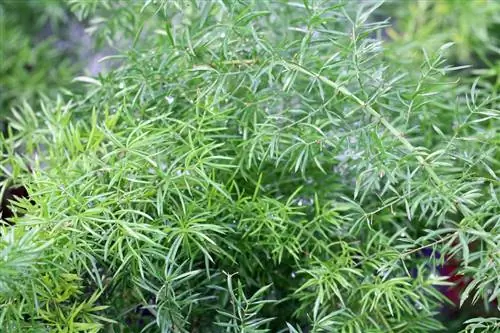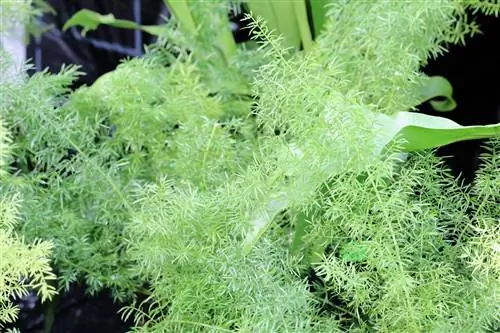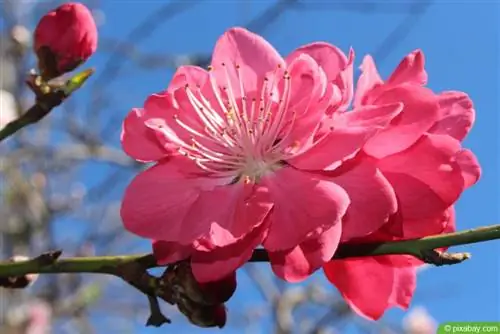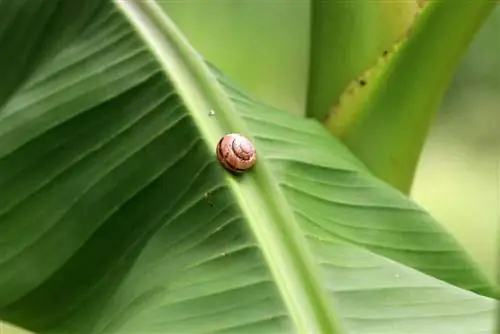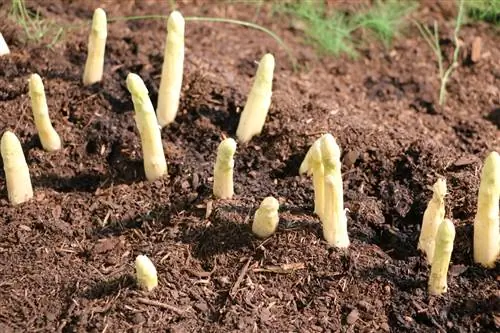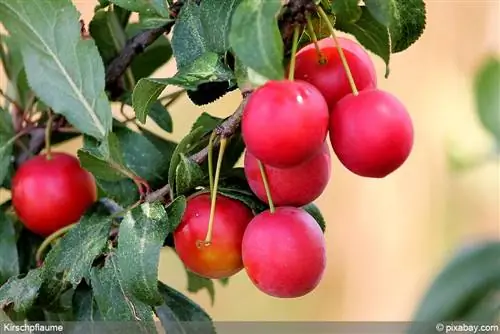- Author admin [email protected].
- Public 2023-12-17 03:39.
- Last modified 2025-06-01 06:48.
Ornamental asparagus can have many different orientations. Compact, climbing or high - the choice is large. You can find out here how the culture turns out from location to propagation to overwintering.
Location
The location should be bright but not too bright. Morning sun and evening sun are ideal. Places facing east and west are therefore suitable as locations. However, blazing midday sun should be avoided. The plants react to this by dropping leaves or yellowing of the false leaves. But shade is also unfavorable. If the plant is too dark, the loss of foliage must also be expected. In addition, the following criteria are crucial when choosing the location:
- high humidity
- Protection from drafts
- Avoid temperatures below 13 °C
Note:
Experience has shown that the bathroom and kitchen are particularly suitable for houseplants. However, they can also be cultivated outdoors in summer. However, on the south side they should be covered.
Substrate
Which substrate is used depends partly on the particular type of ornamental asparagus. In general, however, the following requirements should be met:
- permeable
- moist
- humos
- moderately nutritious
Plant soil with added coconut fiber or houseplant soil are therefore well suited.
Pouring
The soil should always be slightly moist. This is especially true for the growing period from spring to late summer. If the root ball or the substrate around it dries out, the plant reacts with baldness.
There are also a few points to pay attention to when watering. These include, among others:
- Avoid waterlogging
- immersion watering is ideal
- Water should be at room temperature
- use soft water
It is optimal to place the entire pot in a bucket of water and wait until no more air bubbles rise from the soil. The water should then be able to drain away.
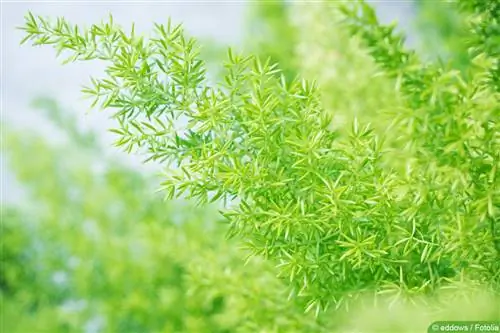
Suitable sources for the water are:
- stale tap water
- filtered water
- Rainwater
- untreated water from aquariums and ponds
- soft tap water
It is best to bring the water to room temperature before watering. This can be achieved, for example, by leaving a bucket of water or a watering can in the room in question for several hours.
Notes:
A coaster is better than a planter. This allows any water that subsequently escapes to evaporate more easily. A drainage layer should also be installed.
Fertilize
Here, ornamental asparagus is particularly easy to care for. Fertilizer is applied every two weeks from spring to late autumn. Green plant fertilizer is suitable. This should be administered in liquid form with the irrigation water.
This avoids chemical burns on the roots as the nutrients are distributed more evenly throughout the substrate.
Intersection
Regular cutting of the ornamental asparagus is not necessary but possible. Potential reasons for this include:
- kinked shoots
- Infestation with pests
- Diseases
- Discolorations
- Barberness
In these cases, the shoots are cut off just above the ground. Even if a complete radical cut has to be carried out, the plant usually grows back again. The prerequisite, however, is that she is otherwise he althy. It is also important that you proceed correctly.
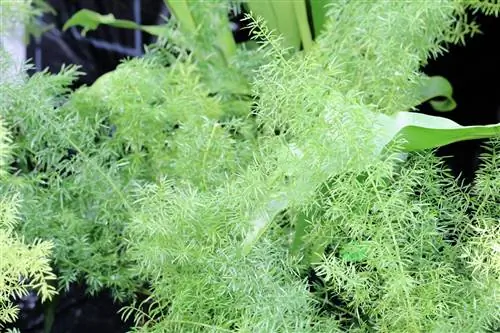
The key here is a cutting tool that meets the following criteria:
- clean blades
- sharp cutting edges
- quick drying
Sharpened scissors with disinfected blades are ideal. In addition, the measure should be carried out in such a way that the cut surfaces can dry in a short time.
Wintering
Overwintering ornamental asparagus is comparatively easy. Ideal are:
- sufficient humidity
- bright location
- don't let it dry out
- Temperatures between 10 and 13 °C
Note:
During the winter, the plant can also be placed towards the south, as the sunlight is then not as intense. However, in the spring after overwintering, the blazing midday sun should be avoided again.
Diseases, pests and care errors
The main problems with ornamental asparagus relate to care errors and the resulting rot and mold. However, diseases and pests rarely occur. However, more common are:
Leaf loss
A plant of this variety tends to drop leaves if it is not kept sufficiently moist or is too dark or too light. Baldness is often due to an incorrect location or errors in watering.
Mold
The plants react very sensitively to waterlogging. Rot and mold are the possible consequences. This can cause significant damage to the roots and lead to the death of the plant. Rescue is possible if
the condition is recognized and treated early. This requires the removal of the entire substrate and the affected parts of the plant.
Discolorations
If yellow or brown discoloration occurs, dryness or excessive exposure to sunlight are usually responsible. A change of location is therefore advisable.
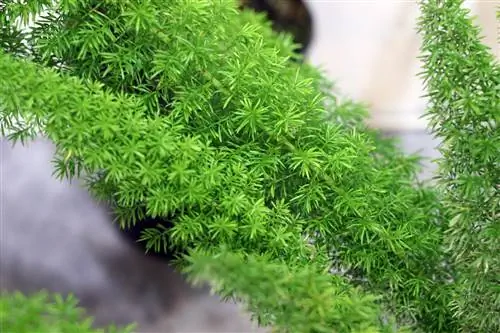
Propagation of ornamental asparagus
In spring you can propagate your ornamental asparagus by dividing the root tubers with a sharp knife. These are then placed in pots with standard potting soil and watered lightly. The same procedure is advisable if there is no longer enough space in the existing pot. Further care corresponds to that of older plants.
You can also propagate ornamental asparagus by seeds. There is extensive instructions on this topic here: Properly propagate ornamental asparagus.
Varieties
Ornamental asparagus can be found in numerous varieties and cultivated forms. However, the following are particularly popular in Europe:
- Asparagus densiflorus
- Asparagus setaceus obsolete also known as Asparagus plumosus
- Asparagus Sprengeri
They differ primarily in their appearance. Asparagus densiflorus is the umbrella term for the varieties Sprengeri and Meyeri. Asparagus Sprengeri is extremely robust and can produce hanging shoots up to one meter long. It is therefore ideal for growing in a hanging basket.
Asparagus setaceus is also known as Asparagus plumosus and fern ornamental asparagus. It is reminiscent of a fern and also proves to be resilient.

